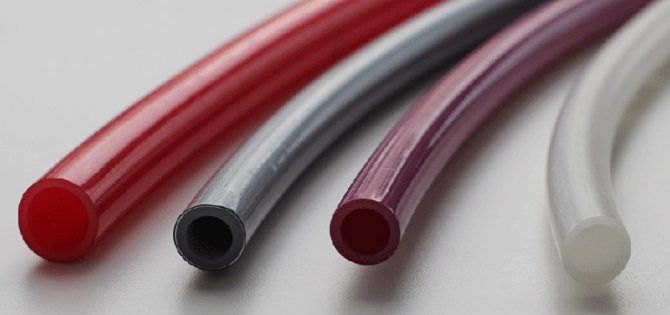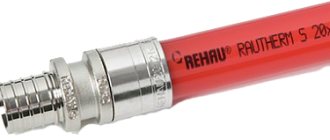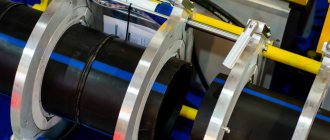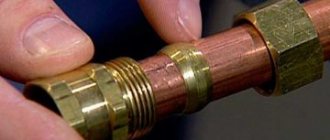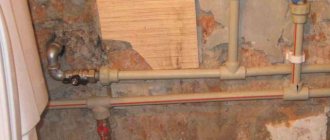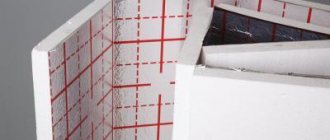Material features
Polyethylene is produced by polymerizing ethylene. In the process of stitching, the chemical composition of the material does not change - this technology significantly improves the characteristics and capabilities of polyethylene, that is, the applicability of the finished product expands.
The most important advantages of such pipes include:
- resistance to high temperatures: without pressure can withstand up to 200 ºC without changing the configuration;
- high shock resistance, up to temperatures down to -50 ºC;
- the presence of a balance between elasticity and hardness;
- are not afraid of oxidation;
- pipes have excellent smoothness and flexibility, able to neutralize mechanical vibrations and sounds;
- not exposed to chemicals;
- no heavy metals are present in the material;
- the ability of the material to bend easily without being damaged;
- small size, light weight, long service life.

Such polymeric materials have the property of shrinkage, that is, they can take their original shape after a certain period after stretching. In addition, special complex tools are not required for the installation of XLPE pipes.
Advantages and Disadvantages of XLPE Pipes
Crosslinked polyethylene (PE-C or PE-X) is a polyethylene with cross-linked molecules. When long molecules of ethylene polymer are crosslinked using various methods (chemical and physical), hydrogen atoms are removed from them, free carbon bonds are bonded to each other and form a bulk cellular network.


The crosslinking gives the PE-X significant strength compared to conventional polyethylene.
As a material for water supply pipelines, XLPE has many advantages:
- durability - the service life reaches 50 years or more;
- corrosion resistance;
- frost resistance;
- strength and at the same time flexibility and ductility - the pipe is chip-resistant, not brittle; to a certain extent, the material can recover after deformation;
- resistance to hydraulic shocks;
- resistance to high temperatures - cross-linked polyethylene can withstand heating up to + 95 ° С (in case of accidents for a short time - up to + 110 ° С); it can be used in heating systems;
- ease of installation, including with your own hands;
- ease of modernization of the system - the pipe is easy to cut, insert, for example, a tee and connect a battery or a tapping point;
- high hydraulic characteristics - the pipe has a smooth inner wall and is not overgrown with magnesium and calcium salts; there is no need for periodic cleaning of pipes from deposits;
- harmless to humans and animals;
- inertness to various chemical compounds, water in pipes does not acquire foreign odors and tastes;
- has a low weight, is easily transported, stored;
- aesthetics;
- easy maintenance - no need for regular oil painting, pipes are easy to clean.
Disadvantages of PE-S:
- the most serious drawback is the destruction of polyethylene under the influence of ultraviolet radiation; in principle, it is possible to lay pipes in opaque boxes and covers - but this is an inconvenient and uneconomical way of installing pipelines;
- foil-reinforced products have less flexibility;
- high price.
Polyethylene crosslinking technology
Stitching is needed to eliminate one of the main disadvantages of the material - thermoplasticity. Thanks to this process, XLPE piping remains flexible and does not change its shape even at temperatures above 80 ºC.
It should be noted that due to the saturation of the material with pure carbon, its melting begins only when it reaches 400 ºC.


The technical characteristics of the product are influenced by the stitching method, which is:
- silane;
- peroxide;
- electron beam.
The first method involves carrying out a substitution reaction. For the second, the raw material is mixed with an inhibitor, and the crosslinking itself is carried out under pressure. The third method consists in conducting irradiation, during which the bonds are changed due to substitution.
Do-it-yourself pipe installation
Installation of plumbing and heating systems made of cross-linked polyethylene can be easily performed independently. Below, the technology for assembling systems from pipes and fittings is described in stages - it is simpler and does not require special skills and equipment.
Required tools and materials
For self-assembly of XLPE pipelines you will need:
- special scissors for cutting workpieces or an angle grinder ("grinder") with cutting discs;
- puncher or electric drill for punching holes in the walls;
- calibrator;
- round file with a fine cut;
- two adjustable wrenches are required to install compression fittings;
- For the press-on method, you will need a manual mechanical press to crimp the fittings.


Drawing and diagrams
It is better to start the preparation of any work with the design with drawing a plan with the exact dimensions of future systems and indicating the connection points for faucets, machines (washing and dishwasher), meters, columns or a heating unit. The plan will help determine the required number of pipes and accessories.
Work order
Before starting work, it is necessary to prepare tools and materials, cut the pipe into blanks, clean the ends of the blanks from dirt and debris, and clean the burrs with a file.
The pipes are connected using compression fittings in the following order: the compression nut is unscrewed, put on the pipe; insert the workpiece into the fitting; tighten the nut by hand. Then, using wrenches, tighten the nut: one turn and a quarter for pipes with a diameter of up to 25 mm, one turn for a diameter of 32 mm.
It is convenient to hold the fitting body with one key, and with the other, rotate the nut.
Assembly by pressing method is carried out in the following order 6
- on top of the end of the workpiece, put on a crimping ring - press sleeve;
- insert the inner nipple of the fitting body into the tube;
- put the clamps of the hand press on the sleeve;
- squeeze with effort and until the press handle stops. Release and remove - ring dents from the press should appear on the sleeve.
Installation video
Our video will help you to see all the nuances of assembling XLPE pipelines:
Installation features
Do not use the compression assembly of the system when installing underfloor heating - this is the least strong connection. Before pouring the screed, it is imperative to fill the system with pressurized water and check for leaks.
It is quite possible to bend the workpiece with your hands. To do this, warm it up with a construction hair dryer, put it in a mandrel, knocked down from boards, plywood or other scrap materials, and let it cool completely. You can use a pipe bender or Volnov's machine.
Dependence of pipe types on installation in different places
The tool for installing polyethylene pipes may differ slightly depending on their area of application. For different systems - heating, cold or hot water supply, sewerage - there are different conditions for the transfer of water, therefore, the products in each case will be different.
For example, to supply cold water, as a rule, single-layer XLPE pipes with a cross section of 16-20 mm are used, which can withstand up to 95 ºC.Often, such pipes are produced by the electron beam method - these products have an affordable price.


For hot water pipes, multilayer structures are needed, since the temperature that they must withstand is within 110 ℃, that is, quite high. For this purpose, in such products, a layer of cross-linked polyethylene obtained by the peroxide method is placed from the inside, an aluminum layer is placed in the center, and another layer of polyethylene is placed on top.
Due to the presence of a central aluminum layer, the pipe becomes strong enough at the bends to prevent oxygen from entering it. But the outer layer of polyethylene is able to protect the pipe from ultraviolet radiation and mechanical damage. The cross-section of such pipes is in the range of 16-63 mm. In the case of heating systems, you can also use multilayer products with parameters 16-20 mm.
Connection by fittings


Pipe connection diagram with clamping fittings.
Installation of products for which cross-linked polyethylene has become the material is carried out in two ways - with the use of press-fit or with compression fittings.
The installation tool must include, respectively, one or another type of fittings. Compression-type fasteners are considered the easiest to install and can be used both when installing pipelines with hot water and in cold water supply systems.
Installation tool:
- spanners;
- split ring;
- crimp nut;
- compression fitting;
- pruning knife.


Pipe joint sealing scheme.
These tools will be enough to connect two pipes together. So, first of all, a crimp nut should be put on the end of one pipe from the side of the connector. After it, it is necessary to fix the split ring in such a way that its edge is located at a distance of 1 millimeter relative to the pipe cut. It should be pushed onto the fitting as far as possible. You do not need to perform any additional actions, including chamfering. The crimp nut must be screwed in with wrenches.
When tightening the nut, be careful not to use too much force, as this can lead to eruptions.
It is possible to fix pipes on the surface of walls or floors in a house (when constructing a heating system with cold water) using the method of laying clips using the technique. With this method of installation, pipes can be fixed anywhere.
Plumbing can be installed independently, but it is advisable to periodically consult with professionals. There is always a high risk of causing all sorts of damage that negatively affects the performance of the entire installation. If the installation and connection are performed correctly, their further maintenance in case of malfunction or other problems will be much faster and easier.
Types of fittings
It is very simple to bend pipes made of cross-linked polyethylene - for this they only need to be warmed up with a construction hairdryer. However, when installing the system, you may need not only bends, but also the joining of individual pieces of pipe - in this case, fittings are used.
There are these types of fittings according to their functional purpose:
- tees and crosses;
- corner details;
- couplings;
- stubs;
- drives.
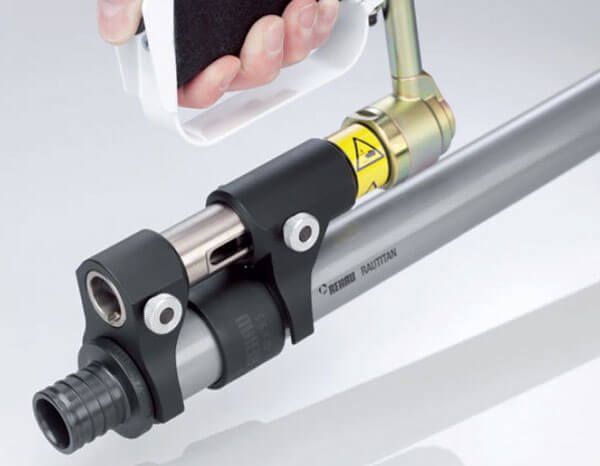

In those places where it is planned to make a change in the direction of the pipeline, corners are usually used. On straight sections, couplings are used for joining. If it is required to build up an additional section to the finished pipeline, then squeegees are used. The purpose of the tees and crosses is to lay the pipeline, and the plugs are used to close the ends.
At the same time, there are several types of materials for fittings:
- polyvinyl chloride;
- polyethylene;
- polypropylene;
- combined material.
The most commonly used brass fittings. It is necessary to connect pipe sections of the same cross-section with straight fittings, and with reduction fittings of different diameters.
Which pipes are better to use
For floor lines, only those circuits are suitable that can withstand high temperatures.
Today on the market there is a variety of products made of the following materials: copper, metal-plastic, cross-linked polyethylene. Separately, we will talk about galvanized pipe-rolling materials.
Each type has its own characteristics, and is intended for use in specific conditions.
XLPE PEX pipes
Pipes made of cross-linked polyethylene have excellent performance characteristics due to which they receive an indisputable advantage over other materials, therefore they are popular both for cold water supply and for laying in a warm floor structure.
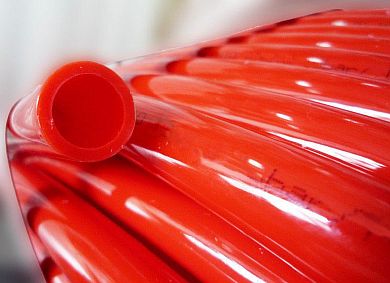

The material for their manufacture is polyethylene with a certain density. Stitching of products is carried out according to several methods.
Depending on the production process, the pipeline is of different classes:
- PEX-a - high-density polyethylene is used in the manufacture. The production method is peroxide, it consists in melting polyethylene under the influence of high temperature. After that, the resulting amorphous mixture is squeezed out through a special forming hole, this method is called extrusion.
PEX-a is a multi-layer construction with an aluminum insert between the layers, which helps to maintain the shape of the product. A special glue is used to connect the layers; it does not change its properties under the influence of temperature.
For your information! The product is capable of passing oxygen to the coolant. To eliminate penetration, manufacturers began to equip it from the outside with a protective EVOH coating - a layer of thin plastic (polyvinylethylene).
- PEX-b - for its manufacture, medium density polyethylene is taken, which softens to a solid consistency. With this method, crosslinking is done after extrusion.
- PEX-c - the raw material in this case is also polyethylene of medium density. Stitching is carried out at a temperature equal to the environment, while the state of the material is solid.
Cross-linked polyethylene hoses are widely used in the installation of underfloor heating, but PEX-a is more often used, since they have good elasticity and allow you to lay a line with a bend of up to 5 diameters.
PEX-b are harder and therefore break easily. And PEX-c does not tolerate high temperatures, therefore it is more often used for cold water. In addition, products made from this material are durable and lightweight, which is a plus for DIY installation.
PEX-a pipes have memory - when deformed, they are able to completely restore their shape, for this they need to be heated. PEX-b do not have such properties, while PEX-c has this property downgraded.
Polyethylene PE-RT
Pipe rolling PE-RT is modified, it differs from PEX in the absence of seams. The system made of such tubes is practically silent, withstands subzero temperatures, but high positive temperatures, although it tolerates well, but not for a long time.
In addition, this material is susceptible to aggressive substances, and there is no structural memory. But, despite this, heat-resistant polyethylene is widely used in underfloor heating, as it has an affordable price.
Reinforced plastic
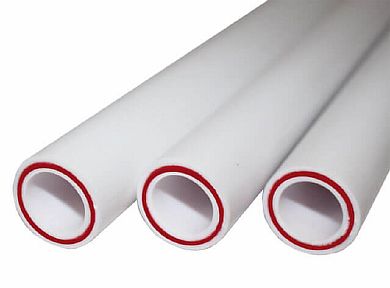

A metal-plastic pipe for a warm floor is an excellent option. It is flexible and pliable, and lends itself to bending even without heating.In addition, the material is durable, tolerates temperature changes well and is environmentally friendly.
The metal-plastic pipeline consists of several layers - inside there is cross-linked polyethylene, then metallized foil, and on the outside there is a polymer coating, it protects against mechanical damage. In this design, corrosion does not form and scale build-up does not occur. With proper installation, the pipeline will last more than 50 years.
If we compare which is better - metal-plastic or cross-linked polyethylene for underfloor heating, then we can note the high thermal conductivity of plastic. But at the same time, there is a great risk of the coil breaking, and since such a product does not have the ability to restore its shape, this area will have to be removed.
Metallic
Metal pipes for warm water floors are produced in the following types:
- Copper - have a high cost, so they are not very popular when installing hydraulic floors. In addition, it is not easy to lay such a pipeline, special equipment is required, and it is unlikely that it will be possible to install it yourself.


However, it should be noted that a copper pipe is ideal for a warm floor, as it has excellent characteristics:
- high thermal conductivity;
- durability;
- not susceptible to corrosion;
- plasticity and strength.
- Corrugated steel made of stainless steel is a relatively new type that is well suited for underfloor heating, but due to the high price, they are not often used. The product has a protective polymer coating, and the stainless steel does not corrode, it perfectly tolerates mechanical, chemical and temperature influences.
In addition, such a model has increased flexibility, laying according to the most complex scheme is possible, without the risk of creases.
Summing up, we can saythat the most popular models that are used for underfloor heating are reinforced plastic pipe or XLPE loop.
They have good performance and are affordable. But if financial resources allow, then it is better to use a metal (copper) pipeline, it has high thermal conductivity and durability.
Fastening technique for compression fittings
You will need two wrenches and a secateurs to work with this type of part.
The assembly of XLPE pipes into a single pipeline using compression fittings is performed in several steps. In the first step, a crimp nut is placed at the end of the pipe. Its thread must face the connector. Next, the split ring is fixed, setting it so that the distance from the pipe cut to the edge of the ring is 1 mm.


At the end, a section of a pipe made of cross-linked polyethylene, with a nut and a ring put on it, is pushed all the way onto the fitting fitting. After that, use wrenches to tighten the crimp nut tightly. Note that before sliding the pipe over this fitting, it does not need to be disassembled or chamfered. The only precaution when working with these elements is to control the tightening force of the nuts so that the pipe does not deform.
Installation methods
Cross-linked polyethylene systems are mounted in three ways: compression, press-on, electric welding. The features of all three methods are described below.
Compression
This method uses compression fittings (see photo). Structurally, they consist of external compression nuts, O-rings, thrust rings, threaded body (collet).


Assembling the system using compression fittings is the easiest method of installation, allowing you to do without special tools. This is a collapsible connection method - if necessary, the fitting nuts can be unscrewed.
Press-on
For the cold pressing method, press fittings are used, the design is shown in the figure. This type of pipeline assembly is one-piece.The press sleeve is crimped with a hand press and firmly presses the pipe onto the inner O-ring of the body.


A special hand-held press is used to assemble the system, but it is inexpensive, easy to use and can be borrowed from friends - yes you can find it.
Electrowelding
This is a very convenient but expensive way of joining polyethylene pipes - couplings are expensive. There is a heating element inside the sleeves. The ends of the workpieces are inserted into the coupling, current is supplied to the coupling from a special welding machine, the coupling heats up, heats the pipes and solders all three parts into a single whole.


It is very important to thoroughly deburr the ends and do not move the connection until it cools completely. The disadvantage of this type of assembly can be considered the lack of a large assortment of various fittings, which makes it difficult to conveniently connect taps, mixers, meters, equipment to the system.
Which way is better
All installation methods provide reliable tight connections, but for hidden systems (for example, underfloor heating), only welding (soldering) and press fittings are used as they provide a more reliable connection.
The electric welding method requires special equipment and sufficient skills; in addition, couplings with pressed-in electric heating elements are quite expensive.
Compression and compression fittings are much cheaper than electrofusion couplings, and connection with fittings is much cheaper.
Systems assembled with compression fittings can withstand pressures up to 2.5 MPa; by pressing - up to 5-6 MPa; welded joints - even more. But in household networks, there is no pressure more than 2.5 MPa, so you should not choose only by this criterion.
Aesthetically, fittings are more compact, and many choose them (and also because of the lower cost and ease of installation). In addition, it should be considered whether the system will need to be disassembled in the future or whether it will be filled with a floor screed.
Joining pipes with crimp connections
Fastening pipe products to press fittings requires the following tools:
- fitting crimp press;
- pruning shears or scissors for cutting the pipe;
- expansion gun with a set of nozzles.
First of all, pipes are cut. It is very important that the cuts are smooth and even, without burrs - special scissors will come in handy for this.
A sleeve is placed on the prepared edge, which will subsequently be crimped. Please note that you need to put on the sleeve before carrying out work on expanding the edge - otherwise, it will no longer fit.
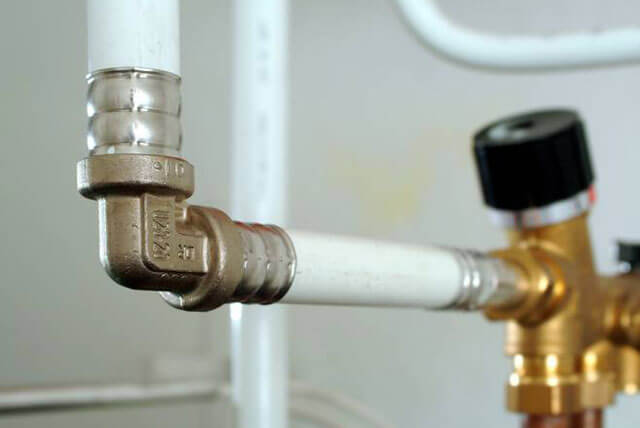

The next step will be to expand the inlet of the pipe by several millimeters with a special gun with a nozzle of the required size. A fitting nipple is inserted into the expanded entrance, making it easier for yourself to work with the special grease included in the kit.
At the last stage, the sleeve on the XLPE pipes is fixed with a special press. Here, too, you need to be careful not to deform the docking station.
On the features of the installation of products from cross-linked polyethylene
There are three types of methods through which the installation of XLPE pipes is carried out.
- Electrofusion fittings. This method is not widely used. Because it requires professional skills and equipment. But on the other hand, this method is effective.


- Press fittings from Bir Pex, Rehau or Uponor. Allows to obtain a one-piece connection with maximum reliability. The emphasis is on the regenerative properties of polyethylene. Thanks to which, after pressing, the material returns to its initial position. Press fittings contain polymers that fill all voids. This ensures maximum contact density.


- Compression fittings. The easiest option for installation.


IMPORTANT! It is necessary to take into account the pressure level in the future system in order to correctly select the appropriate type of connection and equipment. Each of the types of joints is capable of withstanding a strictly defined load in this regard.
